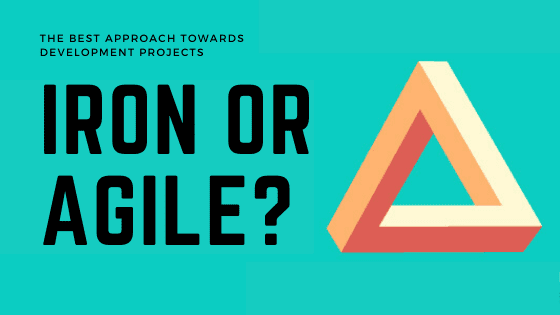If you are looking to get started with a software project, it’s important that you understand the difference between the iron and agile approach, so you can make the right decision when choosing your technology partner. In this article, we will be discussing the difference between both strategies and help you determine which is the best approach towards your development project. Will it be the iron or agile triangle?
Iron Triangle
The “iron triangle” was first defined by Dr. Martin Barnes in 1969 and was used in the context of the waterfall approach, where the scope of a project is fixed while resources and time are variable. The waterfall approach typically took a fixed view of scope and teams made trade-offs between time, budget and human resources.
During development, if the team realized that the scope requires more effort and they will not hit the release date, they’d adjust the launch date (time) and/or add team resources. The ineffectiveness of the waterfall approach in forecasting project requirements along with modern-day design and development imperatives has given rise to the agile framework of development.
Agile Triangle
The adapted agile triangle takes a more fluid approach to scope with the resources and time being fixed. It focuses on two other components, Value- the final product which is delivered to the client, Quality- continuously delivering value to the customer, and the traditional budget, scope and time is grouped under Constraints.
Need of the Future
Software development teams should take cues from both the iron triangle and the agile triangle. With increasing competition, software developers are trying to please their clients by cutting their costs, but whenever there is an addition to the scope, (which takes a lot of developer or product manager time), the project teams often fail to effectively prioritize the client’s needs. Even though the cost comes down, the value and the quality of the project plummets.
To mitigate unnecessary costs and to meet the customers requirements, at the beginning of the project, the product managers should have in-depth discovery sessions with the clients, where they discover “the use of the end product”. As the project progresses, adjustments to scope should be made based on the actual time required to develop the objects and functions, changes in priorities and new insights and information that are likely to emerge. This will allow the team to be more flexible (agile) and adjust to the high priority needs of the project.
This will also allow the scope to be broken down into more manageable components with release dates and a consistent team. Initial scope should be defined at a more high level and the team should take on components of the backlog that they “groom” or refine and build out in real-time (vs trying to figure everything out up front). This could greatly improve the process of creating better user stories/functions and developing them.
Considering this framework and the relationships of scope, resources and time can help manage your project more effectively. This provides an effective, realistic and mutually viable approach to developing your exciting new digital product!
Are you interested in getting a quote on a project idea, please email us at [email protected]. Also, feel free to check out some of our recent projects by clicking here.
